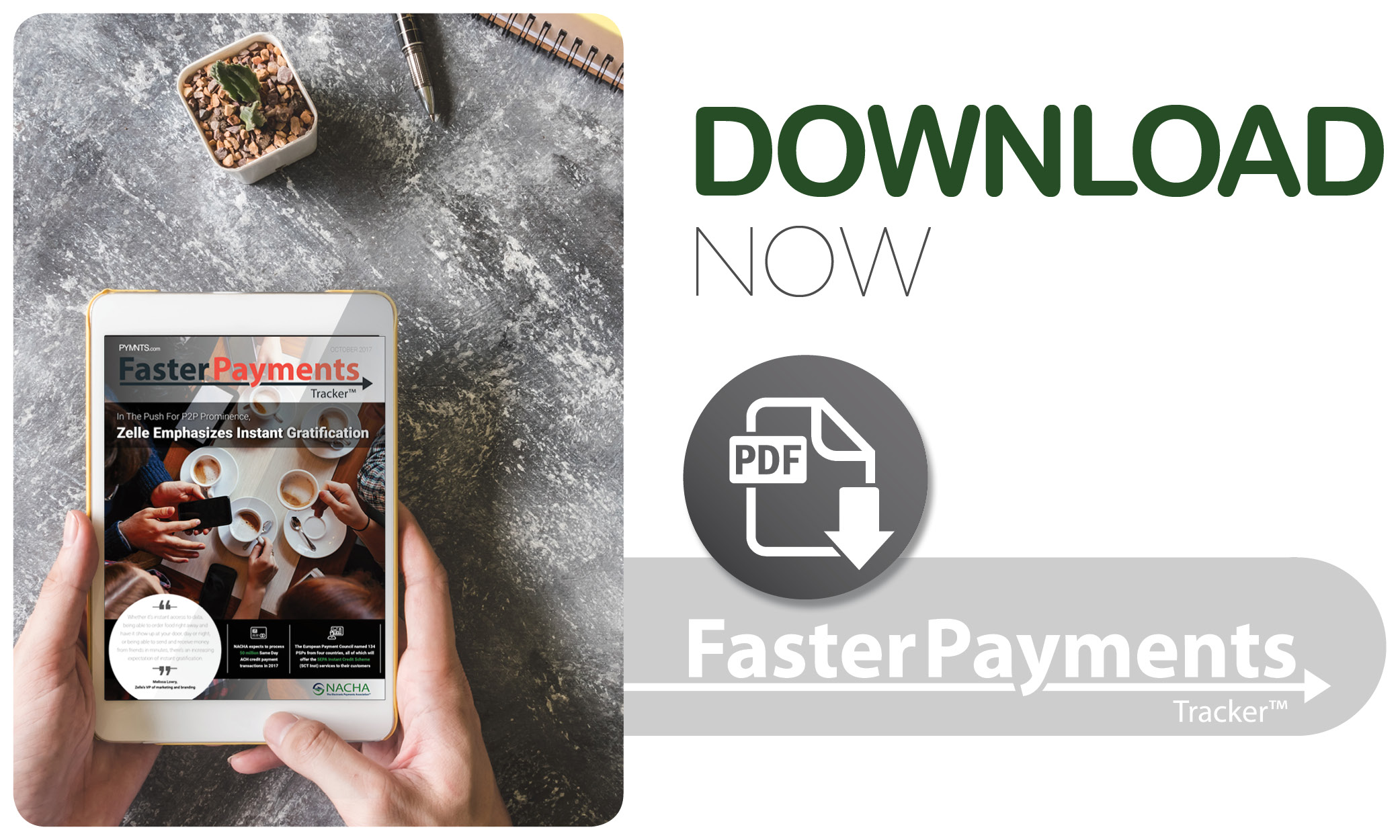In The Push For P2P Prominence, Zelle Emphasizes Instant Gratification

P2P FinTechs like Venmo and Square Cash gained popularity by winning over millennial users, which was rad. Now, the bank-backed platform Zelle is escalating competition by targeting millennials and their parents. Is it game on? In this month’s PYMNTS Faster Payments Tracker™, powered by NACHA, Melissa Lowry, VP of marketing and branding at Early Warning Services, the bank-owned company that runs the Zelle network, discusses the advantage of a P2P service supported by traditional FIs and the thinking behind offering Zelle as a standalone app. Plus, notable faster payments headlines, inside the latest Tracker. It’s lit.
The fight for dominance in the person-to-person (P2P) payments market has escalated over the past few weeks, with banks and credit unions rolling out a new service to help them compete with newer FinTech companies.
In recent years, several FinTechs have gained popularity with consumers by offering the ability to quickly and electronically send money to friends and other contacts. Notable players in the FinTech P2P space include Square Cash and PayPal-owned Venmo, which has gained popularity for incorporating social media elements to appeal to younger consumers while helping users overcome the “awkwardness of money,” as the company likes to say. According to recent reports, Venmo users alone transferred approximately $14.8 billion during the first half of 2017.
Traditional financial institutions appear to be recognizing that the arrival of these startup FinTechs has made the faster payments landscape more competitive – and they appear ready to go on the offense.
In June, more than a dozen banks and credit unions made P2P mobile payments available through Early Warning’s Zelle platform, which was previously operated by a group of banks under the name clearXchange. With the Zelle service in place, customers of participating banks can send money to contacts from their financial institution’s mobile app within seconds, using information like email addresses or cell phone numbers. Another 17 financial institutions are planning to connect to the Zelle platform in the future.
Zelle made news again in September when it announced the launch of a standalone app to be downloaded from Apple’s App Store or Google Play. The app allows users to send and receive money – even if they belong to a financial institution that isn’t part of the Zelle network – using eligible Visa and Mastercard debit cards as opposed to the checking and savings accounts embedded in participating banking apps.
To discuss Zelle’s strategy in offering a standalone app, PYMNTS recently caught up with Melissa Lowry, the company’s vice president of marketing. Lowry offered an overview of the state of the P2P market and explained how banks are positioned to use Zelle to address the rise of newer challengers in the race for faster payments.
The Standalone Strategy
Zelle claims its service has the potential to reach 86 million consumers using participating banks’ mobile apps. In addition, its participating banks and credit unions have seen a 300 percent increase in new customer enrollments since launching the service through their banking apps in June, a sign that Zelle is poised to reach a wide audience, according to Lowry.
By offering Zelle as a standalone app, participating financial institutions are looking to expand the reach of the Zelle service to financial institutions as well as customers not currently participating in the network, Lowry said. Enabling users outside the current network of banks and credit unions to use the standalone app without switching their banks is another way for Zelle to highlight its value proposition, she added.
“People at banks in [the Zelle] network are still sending money to friends and family who are at a bank that isn’t yet in our network,” Lowry said. “We want those out-of-network users to be able to get the Zelle experience as well.”
The strategy, she explained, is to allow consumers additional options to use the Zelle service – and, thus far, it appears to be working. During the first half of 2017, prior to the app’s launch, Zelle reported the banks in its network processed approximately 100 million P2P transactions. The service claims the value of these transactions is around $33.6 billion, and that 50,000 new consumers are registering to receive payments from the Zelle service on a daily basis.
Selling Parents (And Their Millennial Kids) on P2P
P2P services like Venmo have become popular with millennial consumers, not only for offering faster options for parties to exchange money, but also for incorporating social media elements intended to make transactions more engaging – and comfortable – for its users. But while Venmo might appeal to a younger crowd, Lowry believes Zelle’s relationship with a large network of traditional financial institutions will help entice older consumers with more disposable income to use the P2P service.
As an example, she posited that a 55-year-old mother who needs to send money to her child in college, but has never used her smartphone to transfer money before, will be more likely to access and use the service offered through her bank’s app rather than downloading an untested, standalone money transfer app. Meanwhile, her child on the receiving end of the transfer gets the benefit of seeing the money appear in his or her account within a few minutes. There’s no longer the need to wait for a check to be delivered through the mail and picked up at the student union.
Because P2P money transfer features are relatively new, older users’ existing relationships with their banks can go a long way in terms of endorsement, Lowry said. Seeing the P2P transfer service available in a mobile banking app with which they are already familiar will help older consumers get more comfortable using a P2P service, especially if that service is backed by their banks.
“We are in a unique position with Zelle because of relationships with the banks,” she noted. “We have an opportunity to really broaden who uses P2P from a more millennial audience to [a] broader mainstream audience.”
Tapping into that existing relationship with banks also enables Zelle to bring older consumers into the P2P platform for more expensive transactions, Lowry added. Based on Zelle’s review of transaction description information from what users have entered into the platform’s memo field, some of the top use cases for payments indicate more adult-level usage of the service. In addition to popular use cases like splitting the cost of dinner at a restaurant, drinks at a bar or concert tickets, Lowry also noted consumers are using the service for higher value transactions, such as rent splitting, child support and alimony expenses.
And, according to Lowry, offering a bank-backed solution for sending money quickly could open new possibilities for the types of high-value transactions consumers want to make.
“I think we’re in a unique position to expand what P2P means in [the] marketplace, because we can reach people who wouldn’t have even considered it before and help get them past that skepticism – [largely] because of that trusted bank relationship,” she explained.
Addressing Consumers’ Need for Speed
With the rise of P2P payment services, Lowry said, banks are getting the message that consumers are increasingly expecting to access and receive their funds quickly (also known as instant gratification). She also noted that demand for faster service is a trend not limited to the financial services world.
In addition to offering customers a faster way to send money, Lowry also sees potential for P2P platforms in disbursements solutions like insurance claims, for smaller merchants to more easily pay suppliers and make payment to several types of gig workers, including gardeners, personal trainers and babysitters.
Whatever the motivation, consumers and businesses want fast access to their money, and banks and other money transfer providers must deliver to stay competitive, she said.
“There’s an increasing consumer expectation around speed,” Lowry explained. “Whether it’s instant access to data, being able to order food right away and have it show up at your door, day or night, or being able to send and receive money from friends in minutes, there’s an increasing expectation of instant gratification.”
When it comes to being able to send money to friends and family faster, Lowry said, consumers now have that same need for instant gratification from their banks. Moreover, bank consumers are becoming increasingly frustrated with making payments using cash and checks, and would instead rather be able to move money in real time.
A recent survey by Bank of America, the first major bank to offer Zelle through its mobile app, supports that argument. The survey found 68 percent of respondents said they use P2P technology for its convenience and speed of service. The survey also found 16 percent of respondents use the P2P services because they are tired of relying on cash or checks to make payments.
“My lofty hope is we can help people not think about payments so much and help them get on with the business of living their lives,” Lowry said.
. . . . . . . . . . . . . . . .
TO DOWNLOAD THE OCTOBER EDITION OF THE PYMNTS FASTER PAYMENTS TRACKER™, POWERED BY NACHA, CLICK THE BUTTON BELOW.
About the Tracker
The PYMNTS Faster Payments Tracker™, powered by NACHA, is your go-to resource for staying up to date on a month-by-month basis. The Tracker highlights the contribution of different stakeholders, including institutions and technology coming together to make this happen.

